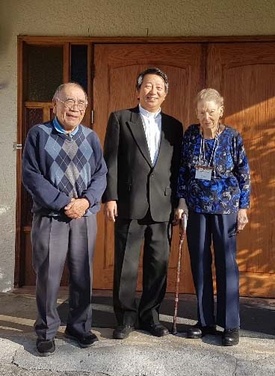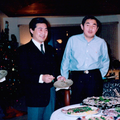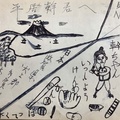As noted previously, Basil’s parents had both been active members of the Holy Cross Anglican mission, and as a small child he had attended Sunday school and kindergarten there before the internment. Upon returning to Canada from Japan, he attended the Anglican Church in Vernon with his aunt and grandmother. When they moved to North Vancouver1 in 1954 they began attending a nearby Anglican Church, Saint John the Evangelist.
In contrast to those Japanese Canadian Anglicans who were excluded from worshiping at Anglican Churches after returning to the west coast after the war, Basil does not recall feeling any discrimination there, and has good memories of being involved in the various activities of the church youth group. Specifically, he recalls going berry picking with them in order to raise money to buy a heifer for an Anglican missionary in Japan who was trying to establish a dairy farm there. This involvement continued until he left Vancouver to work in the sawmill in Devine for five years.
He does not recall exactly when he realized that the Holy Cross Mission was no longer located in its original place, but thinks he probably noticed and became curious about it for the first time when he was taking his mother-in-law to a massage appointment on Cordova Street near where it had been located. However, because he had been such a small child when he had attended Holy Cross Mission before the war, he did not think about it very deeply at the time.
If the older Japanese Canadian Anglicans at that time were thinking about it, he did not hear them talking about it, just as they did not talk with the younger generation about what they had suffered during the war. His curiosity about it was stimulated many years later while talking about the history of the church with other church members including Greg Tatchel, who would soon start his research about what had happened to the Japanese Canadian Anglican church properties that had been taken away from them (see part 1 and part 2).
At some point Basil began to gravitate back towards the church of his earliest childhood, Holy Cross Mission. Even while working as a teacher in eastern BC, he would occasionally spend a weekend in Vancouver and attend Holy Cross at its post-war location. He was married there in 1967, and later had his two children baptized there. When he and his family moved back to Vancouver permanently (around 1985), he was able attend more regularly, except for the summer holidays when he would go salmon fishing with his father-in-law who owned a trawler in Steveston. After the church moved to its present building in 1989, he steadily became more involved in administration of the building and property.
Due to the uprooting, internment, dispersal, dispossession of church property, and various other trials that Holy Cross has gone through in more recent years, Basil is the only remaining member who was involved in Holy Cross (albeit as a small child) before the war. He is known by other members as a constant “pillar” of the church, playing a key role as it has struggled to survive the more recent upheavals mentioned in the first chapter.
In the 1980s a memorial garden containing a columbarium was built next to the church, and Basil was placed in charge of it in about 1990. Since then he has made its care his special responsibility, coming early every Sunday morning and opening it before the other congregants arrive. He still continues to be deeply involved in administration of the church and the memorial garden.
In 2010 the Diocese of New Westminster presented Basil with the ODNW (Order of the Diocese of New Westminster), the purpose of which is to “honor and give special recognition to members of the Diocese who have given outstanding service over a significant period of time in their volunteer ministry.” In announcing the award, the Diocese home page contains the following statement: “Basil has been a faithful member and leader in the parish for many years. When the parish went through a very difficult time, Basil was one of the few who chose to remain with the parish. He accepted the appointment by the Bishop to the position of Bishop’s Warden of the parish, a position he still holds today.”2
When Basil returned to Canada in 1949 at the age of twelve, he left the rest of his family behind in Japan. At that time his younger sisters were just four and five years old. He occasionally corresponded with his mother, who also corresponded with her sisters and mother with whom Basil was living in Canada. He did not have direct correspondence with his father, but used to visit with Shingo Murakami, his father’s old friend, who occasionally informed him how his father was doing. He also recalls receiving some news of his father from the daughter of Mr. Campbell, his father’s previous boss at Campbell Photography Studio.
At some time after Basil came to Canada, his parents divorced. Because this information was kept from him by his mother, aunts and grandmother, he did not learn about it until several years after the fact. He is not sure whether the divorce was primarily due to the stress of what they had been through in Canada (the uprooting, internment, and deportation), their long separation while his mother was away working in Osaka, her conflicts with her mother-in-law, or some other reasons. In any case, both of Basil’s parents became romantically involved with other partners and consequently Basil has a half-brother on his mother’s side and a half-sister on his father’s side.
After coming back to Canada at age 12, Basil never saw his father again. He became ill and passed away in 1983. When Basil learned that his father was very ill, he wrote him a long letter, expressing among other things his regret for not having been in direct contact with him since leaving Japan and mentioning that he had been receiving news about him from Mr. Murakami and the daughter of Mr. Campbell. The letter was read to his father in the hospital by Basil’s mother and sisters who then conveyed back to Basil that tears welled up in his father’s eyes and he seemed heartbroken. Later his sisters sent him his father’s diary and photograph collection.
Basil’s mother visited Canada twice and stayed with Basil’s family in Vancouver, once in the mid-seventies and again around 1985. During her visits, she expressed a desire to stay permanently in Canada and live with his family. However, both her sisters strongly advised Basil against it. As she was frequently talking about her grandchildren she had left behind in Japan, and due to her headstrong personality and the fact that she had been the family member who strongly wished to go to Japan after the war, they were concerned that there would be various problems if she stayed in Canada permanently.
Both of Basil’s sisters still reside in Japan. Megumi married into a family known for making futons and now lives in Hirakata, a small city near Osaka. The husband of Emiko worked designing baseball caps and they live in Sakai City which is also near Osaka. Both sisters’ husbands are now retired. Basil did not have much contact with them right after he came back to Canada, but through his correspondence at that time with his mother was kept informed of what was happening and how the family members were doing in Japan. Both sisters visited Canada in 1993 and Basil rented a van and took them around to the various camps in which they had been incarcerated as children.
Basil himself was never enthusiastic about going back to Japan even for a visit and thinks that this may have been partly due to some form of resentment against Japan for how it started and conducted the war, as well as the fact that Japan has not yet wholeheartedly apologized to the world. However, he felt his attitude change somewhat when his daughter and a cousin visited Japan in 1992. In 1994 Basil visited Japan himself with his son and stayed with his sisters, who showed them around various places including Shimasato, his father’s home village. He felt glad afterwards that he had made this trip despite his earlier misgivings.
Notes:
1. North Vancouver is relatively distant from the Powell Street area and is also separated from central Vancouver by a strait. This would explain why Basil and his aunt and grandmother chose to attend a nearby Anglican Church rather rejoin the Holy Cross Mission which at this time had just been reestablished by Rev. Gale.
2. Diocese of New Westminster homepage
* This series is an abridged version of the original article titled, “A Japanese Canadian Child-Exile: The Life History of Basil Izumi,” originally published in The Journal of the Institute for Language and Culture, Konan University, Vol. 22, pp. 71-108 (March 2018).
© 2018 Stanley Kirk









